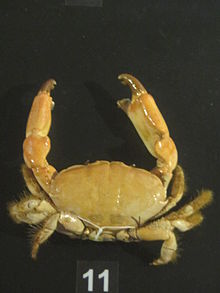| Lachnopodus | |
|---|---|
 | |
| Lachnopodus subacutus | |
| Scientific classification | |
| Domain: | Eukaryota |
| Kingdom: | Animalia |
| Phylum: | Arthropoda |
| Class: | Malacostraca |
| Order: | Decapoda |
| Suborder: | Pleocyemata |
| Infraorder: | Brachyura |
| Family: | Xanthidae |
| Genus: | Lachnopodus Stimpson, 1858 |
Lachnopodus is a genus of crabs in the family Xanthidae, containing the following species: [1]
- Lachnopodus bidentatus (A. Milne-Edwards, 1867)
- Lachnopodus gibsonhilli (Tweedie, 1950)
- Lachnopodus ponapensis (Rathbun, 1907)
- Lachnopodus rodgersi Stimpson, 1858
- Lachnopodus subacutus (Stimpson, 1858)
- Lachnopodus tahitensis De Man, 1889